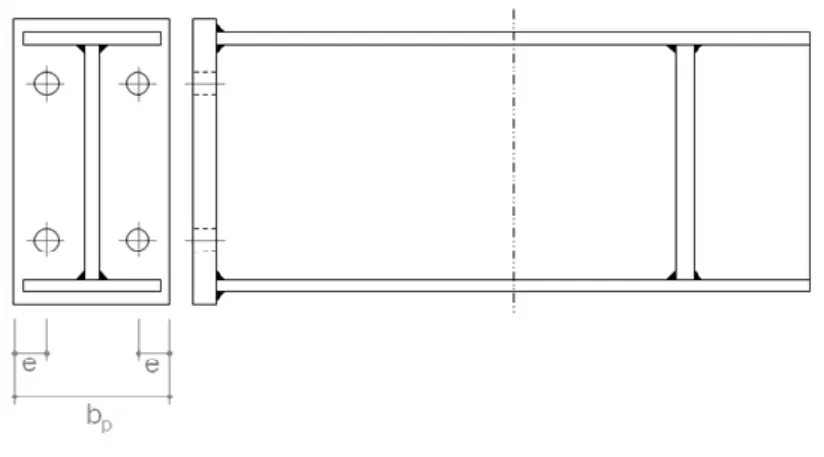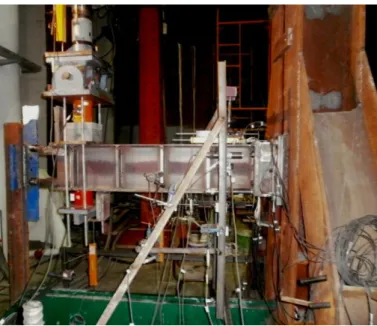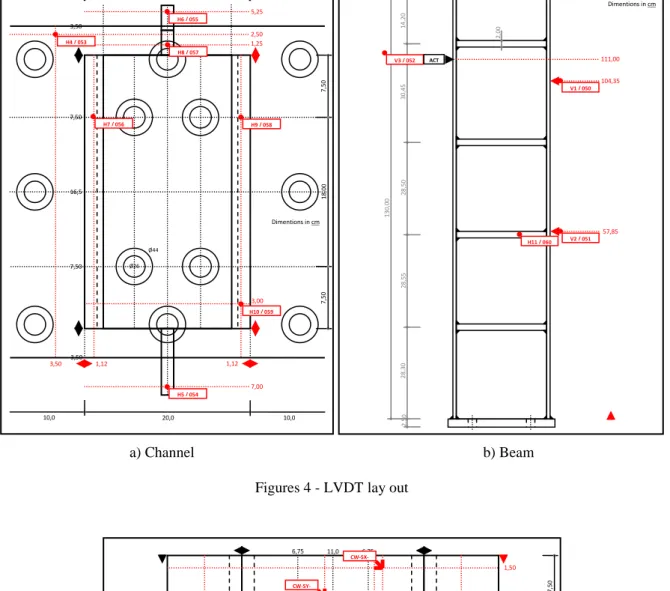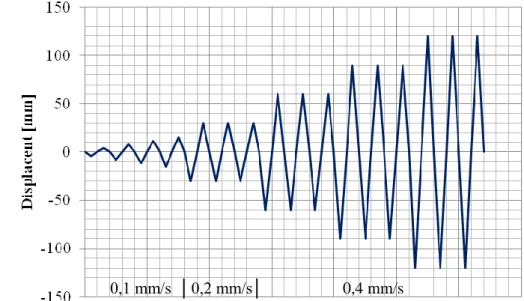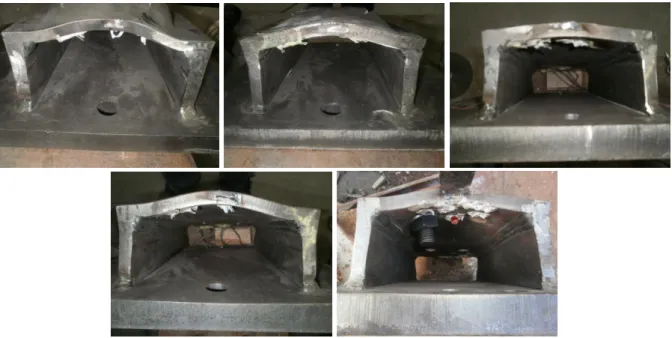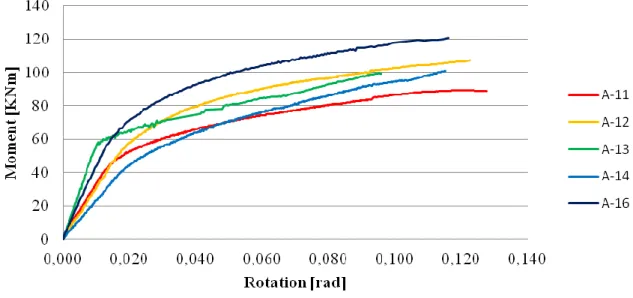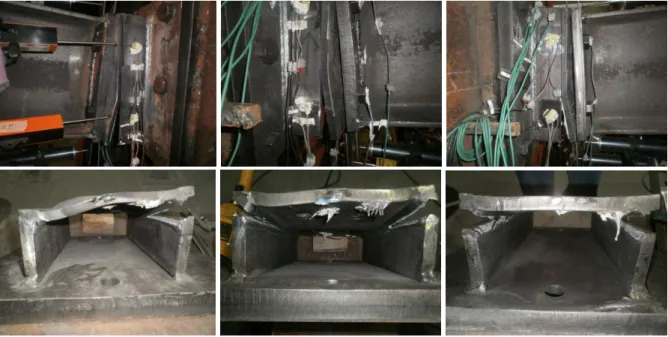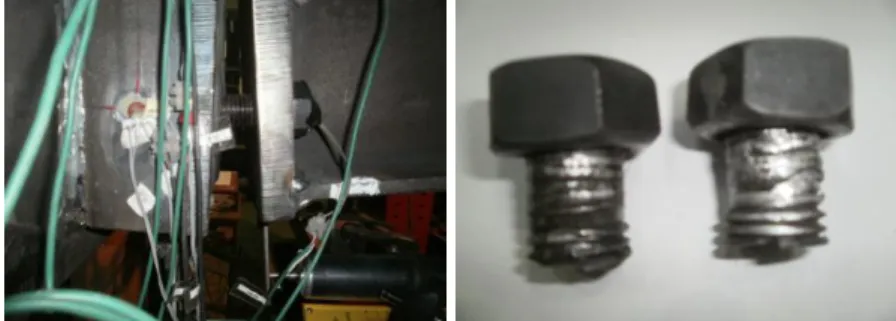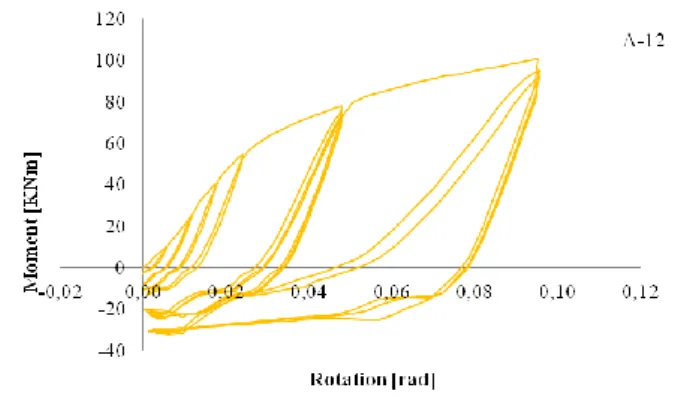PAPER REF: 3743
BEHAVIOUR
OF
WELDED
REVERSE
CHANNEL
JOINT
COMPONENTS OF I BEAM TO TUBULAR COLUMNS CONECTIONS
Luís Magalhães1(*), Carlos Rebelo2, Sandra Jordão3
1 Technical-Scientific Unit of Civil Engineering, Polytechnic Institute of Castelo Branco, C. Branco, Portugal 2, 3
Departement of Civil Engineering, University of Coimbra, Coimbra, Portugal
(*)Email: lmmbmagalhaes@ipcb.pt
ABSTRACT
The main purpose of the investigation presented is the characterisation of the nonlinear dynamic behaviour of steel joints between I profile beams and hollow section columns with welded reverse channel.
The experimental program supporting this investigation consists on the determination of the characteristics of the nonlinear cyclic behaviour of the connection between I profile beams and circular or rectangular hollow section columns. The main goal of this research program is the identification and characterization of the connection components that control the hysteretic behaviour of the connections to be used in seismic areas. The paper presents preliminary test results.
Keywords: Beam-to-column connections, welded reverse channel, monotonic and cyclic
behaviour, components tests.
INTRODUCTION
When compared with other steel shapes, tubular profiles show a privileged structural behaviour due to their ability to withstand axial loads, bending in several directions and torsion, besides considerable advantages in terms of maintenance and aesthetics, at a reasonable cost. The fact that tubular shapes haven’t been such an obvious choice is due to the fact that joints between tubular shapes or to tubular shapes are either completely welded or difficult and expensive, because there is no access to the inside of the tubular shape. Due to this fact, a lesser effort has been directed to research on these typologies, and less comprehensive methods of analysis or code formulation exists for their design.
Eurocode 3 [2] provides some rules for welded connections between tubular profiles but not for bolted connections. However the “Comité International pour le Développement et l’Étude de la Construction Tubulaire” CIDECT is developing a research programme with the objective of develop and unified design approach for steel joints by extending the field of application of the Eurocode 3 component method [4].
The welded reverse channel connection is a good solution to overcome the joint problem in the case of I beam to hollow column connection (Figure 1) since it has a reasonable construction cost, is easy to implement and possesses large ductility through deformation of the web panel.
In the present paper some results are present related to the experimental investigation on the behaviour of welded reverse channel joint components when subjected to bending.
Figure 1 - Welded reverse channel
EXPERIMENTAL INVESTIGATION
The main objective of this experimental investigation is to determine the rotation capacity of the welded reverse channel and the strength, stiffness of the main components of the channel joining detail for both monotonic and cyclic loads.
Parametric range
The prototypes are formed by the reverse channel (two flange plates welded to one web plate with holes for bolted to end plate beam). The steel grade is S275.
The behaviour of the welded reverse channel is conditioned by the main components of its web and flanges: web face in bending and flanges panels in shear, compression and tension. The configurations selected for the experimental tests correspond to a parametric variation on the factors with major influence on the structural behavior of the reverse channel. These parameters are the thicknesses and width of the web and flanges, the distance between bolts in the same row and the geometry of the end plate (Figure 2). The dimensions of the prototypes are listed in table 1.
Table 1 - Prototypes dimensions P p2 (mm) bc (mm) hc (mm) twc (mm) tfc (mm) Prototype
Beam end plate bp (mm) e (mm) 1 85 90 200 12 15 A-11 155 35 2 15 A-12 3 185 A-13 4 220 A-14 5 100 200 A-15 170 35 6 80 A-16 170 45 7 100 75 A-17 170 35 8 10 A-18
Test lay out
The experimental lay out corresponds to a beam to column connection between an I-beam and a vertical steel rigid structure using a reverse channel element (Figure 3). Since the sole purpose is to assess the behavior of the channel prototypes the element to which the channel is holding is rigid enough so that it can be considered undeformable. The channel itself is welded to a stiff plate (25 mm thickness steel grade S355), which is connected to the referred rigid structure by eight bolts (M24 - 10.9), for an easy assemblage. The beam corresponds to an IPE300 profile, with high resistance to bending [1] when compared with the channel, and its out of plane tip displacements are prevented by means of a vertical rolling system.
Figure 3 - Experimental lay out
Loading and measuring devices
The tests were performed with a 100 tf jack, which was connected to the beam tip by means of a hinged device, so that the load applied would remain orthogonal to the beam through tout the whole test. The load applied to the structure was measured by means of load cells placed
between the jack and the beam. LVDT´s were used to measure all of the connection rotation components and to assess displacement at key points throughout the structure (Figures 4a and 4b). Strain gauges were used to assess the stress state at key points throughout the connection and also to assess the strain in the bolts (Figure 5).
a) Channel b) Beam Figures 4 - LVDT lay out
Figure 5 - Strain gauges lay out
1,50 Ø26 Dimentions in cm 5,00 5,00 7,50 Ø44 7,50 1,50 16,5 0 6,75 11,0 0 6,75 6,00 4,50 4,50 18 ,0 0 7, 5 0 7, 50 9,00 22,0 9,00 0 B-SZ-009 B-SZ-010 CW-SX-004 CW-SY-003 CF-SZ-005 CF-SZ-007 CF-SZ-006 CF-SZ-008 CW-SX-001 CW-SY-002 10,0 0 5,00 2, 0 0 13 0, 00 2, 50 3 0, 4 5 14 ,2 0 28 ,3 0 28 ,5 5 2 8, 5 0 Dimentions in cm H11 / 060 V2 / 051 111,00 104,35 57,85 V1 / 050 V3 / 052 ACT Dimentions in cm Ø26 Ø44 10,0 0 3,00 18 ,0 0 7, 50 7, 50 10,0 0 10,0 0 20,0 0 H8 / 057 H4 / 053 H6 / 055 H7 / 056 H9 / 058 H10 / 059 H5 / 054 5,25 1,25 2,50 7,50 7,50 16,5 0 3,50 3,50 2,25 7,00 2,25 3,50 1,12 5 1,12 5
Load strategy
Both monotonic and cyclic experimental tests were performed in displacement control. The cyclic load strategy corresponds to the loading procedure recommended by ECCS normative document for cyclic tests [3]. The ranges used are obtained from the monotonic test elastic displacement using multiplicative factors. These multiplicative factors were 0.25, 0.5, 0.75, 1.0, 2.0, 4.0, 6.0 e 8.0. Figure 6 show the applied cyclic load strategy and for each cycle its test velocity.
Figure 6 - Cyclic load strategy
Results
The present paper presents results for monotonic tests A-11 to A-14 and A-16 and for cyclic tests A-11, A-13, A-14 and A-16. Figure 7a and 7b illustrates the experimental lay out prior and after the test.
a) Before the test b) After the test Figures 7 - Experimental lay out before and after the tests
Monotonic Tests
The deformations of the channels in the monotonic test is caused by the tension of the bolts at the top (Figures 8) and by beam end plate compression at the bottom (Figures 9). In both cases significative plastic deformation is observed.
Prototype A-11 shows the largest top deformation and one of the largest bottom deformations. This is due to the fact that it has the thinner web thickness among all prototypes. Prototype A--14 shows the largest bottom deformation. This is due to the fact that this channel has the widest web, thus increasing its bending deformation.
Figure 8 - Deformation on the top of prototypes A-11 to A-14 and A-16 in monotonic tests
The results from the monotonic tests are shown in figure 10 in terms of moment-rotation curves.
Figure 10 – Moment Rotation diagrams for monotonic tests
The moment rotation curves have two different regions: The initial linear region and the pos-yielding region. In the linear region the behaviour of the connections may be expressed in terms of initial stiffness (Sj,ini) and maximum elastic bending moment (Mj) [2].
Both values depend on the material elastic properties and on the elastic behaviour of the joint, closely dependent on its geometry. The pos-yielding region is characterized by its stiffness and maximum rotation (not reached in the tests reported). The post yielding stiffness depends on the material hardening property and on the geometric/membrane stiffness that is mobilized in plates loaded perpendicularly when the out of plane deformation reaches values in the order of the plate stiffness. Table 2 summarizes the referred values.
Table 2 - Elastic bending moment and stiffness
Prototype Elastic Moment Mj [KNm] Max. Elastic Rotation [rad] Initial Stiffness Sj,ini [KNm] Pos-yielding Stiffness Sj,pl [KNm] A-11 42,4 0,0133 3188,0 285,7 A-12 53,7 0,0177 3033,9 292,2 A-13 53,7 0,0095 5652,6 454,2 A-14 41,5 0,0180 2305,6 441,3 A-16 54,5 0,0126 4325,4 340,7
The monotonic test results show that the thickness and width of the web channel are parameters that influence significantly the behaviour of the connection. When the web thickness decreases smaller elastic bending moments are reached (compare the results of A-11 and A-12). Decrease or increase in the width of the web involves significant variation of rigidity when the same width of beam end plate is considered, because the bending stiffness
of the web is altered. A-14 is an example of such since it is the connection with largest channel web width and the smaller initial stiffness. The variation of loaded area, expressed in the compression zone by the beam end plate width, and in tension zone by the distance between bolts, is also an important parameter in the joint rigidity. Higher rigidity is achieved when the load is applied closer to the channel flanges (compare the results of A-12 and A-16).
Cyclic tests
In cyclic tests the failure of connection was due to the breaking the fillets weld between the web and flanges of the channel in the tension zone (Figure 11).
Figure 11 - Fillet weld failure for channels A-11 (left), A-14 (middle) and A-16 (right)
Failure occurred in channels A-11, A-14 and A-16 during the 120 mm load cycles (Figure 12).
Figure 12 - Failure locus for each cyclic test
Prototype A-13 doesn’t reach failure, having supported all 120 mm load cycles. In this case, the rotation of the connection is caused solely by the sliding of the nuts in bolts thread (Figure 13).
A11
A14
Figure 13 - Details of bolts sliding in joint A-13
In figures 14 cyclic test results are presented in the form of hysteretic moment-rotation diagrams.
a) A-11 b) A-13
a) A-14 b) A-16
Figures 14 - Hysteretic moment rotation diagrams to channels A-11, A-13, A-14 e A-16
In all of these diagrams it is possible identify the different cycles of load strategy. The diagrams to 13 and 14 channels only show the behavior until 90 mm load cycles. In A-11 and A-16 channels it is possible to see the behavior at the failure occurred during the first 120 mm load cycles.
It is also noticed that after the first three cycles (30, 60 and 90 mm) there is a decrease in the connection resistance.
From the hysteretic curves it can be concluded that the behaviors are not equals in positive and negative rotation. This is most evident in the A-13 and A-16 diagrams. The behavior that displays greater symmetry is the diagram A-14. The monotonic tests demonstrate that this is the channel with less stiffness.
The channel A-12 is tested differently. The load strategy was modified in order to take only cycles of compression and decompression at the bottom. The hysteretic moment rotation diagram is present in figure 15.
Figure 15 - Hysteretic moment rotation diagram to channel A-12
CONCLUSIONS
This study shows that there are differences on the behaviour of these joints when welded reverse channel parameters are changed. The loaded area webs thickness and width are parameters with important influence in the structural behavior of reverse channel beam-to-column connections.
The resistance of the connection is higher when the thickness of the web is greater, but related to the stiffness there aren’t significant differences. The result is acceptable given that the web thickness increases but the geometry of the joint is the same. Largest ratios between the widths of the web and beam end plate imply lowers resistance and stiffness. This is justified because for smaller ratios the compressive force transmitted by the end plate is supported by the channel flanges in compression, giving greater resistance and stiffness to the connection, while in the opposite case the resistance and stiffness are conditioned by the channel web in bending. The distance between bolts in the tension row is an influential parameter, because the load distribution across the channel width influences the load transfer path from the web to the flanges of the channel, thus influencing also the channel web plastic deformation. In the cyclic tests the connections strength is conditioned by the strength of the fillets weld. The connection resistance decreases with the load cycles and an asymmetric behavior is observed when cycles in tension and compression are implemented.
Further tests should be performed in order to analyze others geometries, in order to reach conclusions about the influence of others parameters such as the channel flanges width and thickness.
REFERENCES
[1] CEN, Eurocode 3: “Design of Steel Structures”, Part 1.1: “General Rules and Rules for Buildings”, EN 1993-1-1, 2010.
[2] CEN, Eurocode 3: “Design of Steel Structures”, Part 1.8: “Design of Joints”, EN 1993-1-8, 2010.
[3] ECCS, “Recommended Testing Procedure for Assessing the Behaviour of Structural Steel Elements under Cyclic Loads”, ECCS N.º 45, 1986.
[4] Jaspat J.P., Pietrapertosa C., Weynand K., Busse E., Klinkhammer R. CIDECT Report 5BP-4/05: “Development a Full Consistent Design Approach for Bolted and Welded Joints in Building Frames and Trusses between Steel Members Made of Hollow and/or Open Sections”, Application of the Component Method, Volume 1 - Practical Guidelines, 2005.
